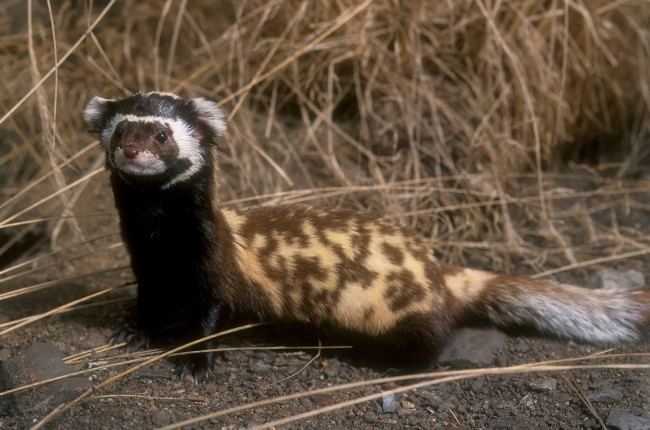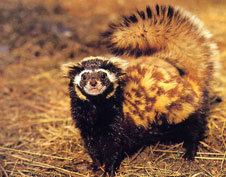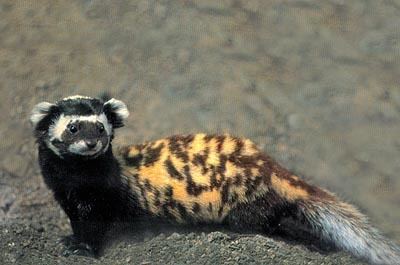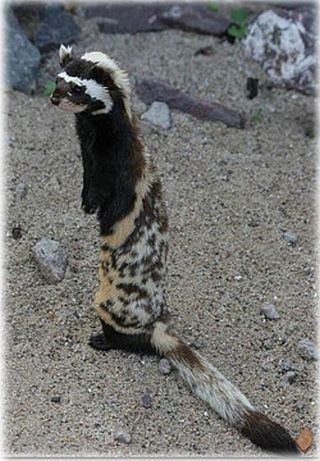Subfamily Mustelinae Scientific name Vormela peregusna Rank Species | Genus VormelaBlasius, 1884 Higher classification Vormela | |
 | ||
Similar | ||
The marbled polecat (Vormela peregusna) is a small mammal belonging to the monotypic genus Vormela within the Mustelinae subfamily. Vormela is from the German word Würmlein,[1] which means "little worm". The term peregusna comes from perehuznya, which is Ukrainian for polecat.[2] Marbled polecats are generally found in the drier areas and grasslands of southeastern Europe to western China. Like other members of Mustelinae, it can emit a strong-smelling secretion from anal sacs under the tail when threatened.
Contents
- Marbled polecat release full
- Description
- Distribution
- Behavior
- Reproduction
- Habitat
- Diet
- Conservation status
- Relation with humans
- Subspecies
- References

Marbled polecat release full
Description

Ranging in length from 29–35 cm (head and body), the marbled polecat has a short muzzle and very large, noticeable ears. The limbs are short and claws are long and strong. While the tail is long, with long hair, the overall pelage is short. Black and white mark the face, with a black stripe across the eyes and white markings around the mouth. Dorsally, the pelage is yellow and heavily mottled with irregular reddish or brown spots. The tail is dark brown with a yellowish band in the midregion. The ventral region and limbs are a dark brown.[3] Females weigh from 295 to 600 g, and males can range from 320 to 715 g.[4][5][6]
Distribution

The marbled polecat is found from southeast Europe to Russia and China. Its range includes Bulgaria, Georgia, Turkey, Romania, Asia Minor, Lebanon, Syria, Jordan, Israel, Palestine, Armenia, Azerbaijan, Iran, Afghanistan, north-western Pakistan, Yugoslavia, Mongolia, China, Kazakhstan and north to the Altai steppes in Siberia.[7][8][9][10][11][12][13][14][15][16] In 1998, a marbled polecat was recorded on the Sinai Peninsula, Egypt.[17]
Behavior

Marbled polecats are most active during the morning and evening.[18][19][20] Their eyesight is weak and they rely on a well-developed sense of smell.[21] Vocalization is limited and consists of shrill alarm cries, grunts and a submissive long shriek.[22]

Marbled polecats are solitary and move extensively through their 0.5- to 0.6-km2 home range. They generally only stay in a shelter once. When they encounter each other, they are usually aggressive.[23]

When alarmed, a marbled polecat will raise up on its legs while arching its back and curling its tail over the back, with the long tail hair erect. It may also raise its head, bare its teeth, and give shrill, short hisses.[24][25] If threatened, it can expel a foul-smelling secretion from enlarged anal glands under the tail.[26]
To dig, such as when excavating dens, the marbled polecat digs out earth with its forelegs while anchoring itself with its chin and hind legs. It will use its teeth to pull out obstacles such as roots.[27]
Reproduction
Marbled polecats mate from March to early June.[28][29] Their mating calls are most often heard as low rumbling sounds in a slow rhythm. Gestation can be long and variable (243 days to 327 days).[30] Parturition has been observed to occur from late January to mid-March.[31][32] Delayed implantation allows marbled polecats to time the birth of their cubs for favorable conditions, such as when prey is abundant.[33]
Litter sizes range from four to eight cubs.[34][35][36] Only females care for the young. Cubs open their eyes at around 38–40 days old, are weaned at 50–54 days and leave their mother (disperse) at 61–68 days old.[37]
Habitat
Marbled polecats are found in open desert, semidesert, and semiarid rocky areas in upland valleys and low hill ranges, steppe country and arid subtropical scrub forest. They avoid mountainous regions.[38][39][40] Marbled polecats have been sighted in cultivated areas such as melon patches and vegetable fields.[41]
Burrows of large ground squirrels or similar rodents such as the great gerbil (Rhombomys opinus) and Libyan jird are used by marbled polecats for resting and breeding. They may also dig their own dens or live in underground irrigation tunnels.[42][43] In the winter, marbled polecats will line their dens with grass.[44]
Diet
Marbled polecats are known to eat ground squirrels, Libyan jirds (Meriones libycus), Armenian hamsters (Cricetulus migratorius), voles, mole rats (Spalax lecocon ehrenbergi), house mice (Mus musculus), and other rodents, small hares, birds, lizards, fish, frogs, snails, and insects (beetles and crickets), as well as fruit and grass.[45][46][47][48][49] They are also recorded as taking small domestic poultry such as chickens and pigeons, as well as stealing smoked meat and cheese.[50][51][52]
Conservation status
In 2008, V. peregusna was classified as a vulnerable species in the IUCN Red List due to a population reduction of at least 30% in the previous 10 years.[53] In 1996, it had been considered a species of least concern. The decline in marbled polecat populations thought to be due to habitat destruction (cultivation) and reduction in available prey by use of rodenticides.[54][55][56]
In Pakistan, it is listed as an endangered species.
Relation with humans
The marbled polecat was once sought for its fur, generally known as "fitch" or more specifically, "perwitsky" in the fur trade.
In 1945, Kabul shopkeepers were reported to have kept marbled polecats to exterminate rodents. Their journals also show some developed an adverse reaction to the strong smell they emit when threatened. Side effects varied from fever to diarrhea.[57]
Other names for the marbled polecat include aladzhauzen (Turkmen), berguznya (Kuban), chokha (Kalmuck), fessyah (stinky in Arabic), abulfiss (Arabic), hu-yio (Chinese), myshovka (Terek Cossacks dialect), pereguznya, pereguzka, or perevishchik (Ukrainian), perevyazka (Russian), perewiaske (Polish), alaca sansar, alaca kokarca, benekli kokarca (Turkish), suur-tyshkan (Kyrgyz), putois marbré or putois de Pologne (French); Tigeriltis (German), mottled polecat (English), sarmatier; Syrian marbled polecat, and tiger polecat.[58] In some contexts it is called the tiger weasel.
Subspecies
The subspecies of V. peregusna include:
